十大词性 句子成分及基本句型讲解及练习(附答案)
基础英语之句子成分和句子结构讲解及练习(含答案)

英语句子成分和句子结构讲解及练习(含答案)主语(subject): 位在句首,动作发出者,指人/物/行为/事情,可以是名词/代词/数字/动名词doing形式/to do不定式/主语从句来做主语The sun rises in the east.He likes dancing.Twenty years is a short time.Seeing is believing.To see is to believe.What he needs is a book.It is very clear that the elephant is round and tall like a tree. (it做形式主语,that引导真正的主语从句)谓语(predicate): 说明主语的动作、状态和特征, 由谓语动词的形态体现时态We study English.We can swim.We wanted to buy a book yesterday.We will go to Beijing.表语(predicative): 系动词之后的成分,表示主语的性质、状态和特征。
可以是名词/代词/数字/形容词/介词(短语)/动名词doing形式/to do 不定式/从句He is a teacher.It is you, who broke the window.Five and five is ten.He is asleep.The picture is on the wall.My duty is looking after this boy.To see is to believe.The question is whether they will come.主语和表语需要用连系动词连接注意:连系动词It is a book. I am at home.It sounds a good idea. Tom looks thin.The food smells delicious. The food tastes good.The door remains open. Now I am feeling tired.常见系动词:be动词,感官系动词(look,sound,smell,taste,feel),补充其他系动词:保持类系动词(remain,keep),变化类系动词(become,go,turn,get),似乎(seem,appear),证明是(prove)宾语:位于动词或者介词后,主语发出动作后的接受者,可以是名词/代词/数字/动名词doing 形式/to do 不定式/宾语从句I like China.Are you afraid of the dog?Why are you looking at him?He likes you.How many books do you need? We need two.I enjoy working with you.I hope to see you again.Did you write down what he said?宾补:对宾语的补充,全称为宾语补足语。
十大词性句子成分及基本句型讲解及练习(附问题详解)
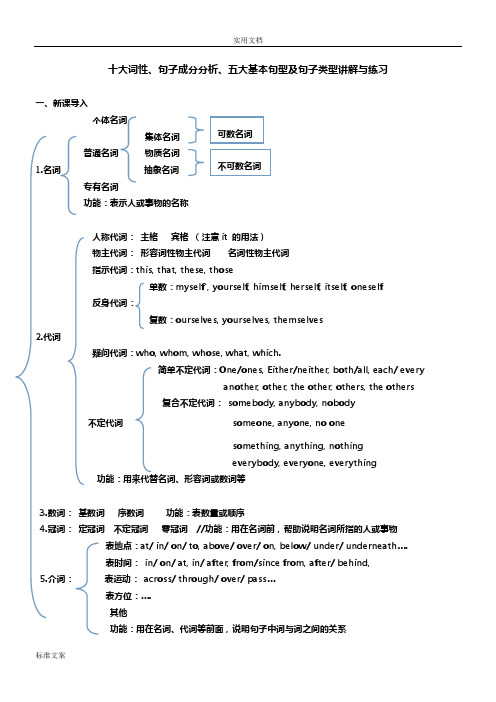
His hobby iscollecting foreign stamps. (动名词短语)
My wish isto become a doctorin the future. (不定式短语)
The news of her success is reallyexciting. (现在分词)(已形容词化)
(2)判断下列句子是简单句并列句还是复合句?
1)We often studyChinesehistory onFriday afternoon.
2)The boy who offeredme hisseat is called Tom.
3)There is a chair in this room, isn’t there?
[To hear more clearly],shesat in the front of the classroom. (不定式)
smile a sweetsmile甜甜的微笑 dream a terribledream做了一个恶梦
die a bravedeath死得英勇 live a happylife过着幸福的生活
4.表语(在系动词之后)
说明主语是什么样的。(身份 状态 特征 类属 性质等) 表语与前面的系动词一起构成谓语。
5.介词: 表运动: across/ through/ over/ pass…
表方位:….
其他
功能:用在名词、代词等前面,说明句子中词与词之间的关系
6. 形容词: 平级、比较级、最高级
功能:用来修饰名词,表示人或事物的特性、性质
7. 副词:平级、比较级、最高级
功能:用来修饰动词、形容词或其他副词,表示动作或形状的特性
英语句子成分和结构讲解分析划分与练习及答案

句子结构及成分①相关概念1.词性的英文缩写在英语学习中,掌握单词词性非常重要。
如果我们在记单词的时只记拼写、读音而不记词性的话,我们就不知道如何使用它们,所以我们在记单词时一定要把单词词性记准记牢。
缩写字母原词代表词性n. noun 名词v. verb 动词vt.transitive verb 及物动词vi.intransitive verb 不及物动词modal v. modal verb 情态动词aux. v. auxiliary verb 助动词adj.adjective 形容词adv.adverb 副词num. numeral 数词interj. interjection 感叹词pron. pronoun 代词prep.preposition 介词art. article 冠词conj conjunction 连词2.及物动词和不及物动词实义动词后面跟宾语时,这个动词是及物动词。
实义动词后面不跟宾语时,此时这个动词是不及物动词。
The door opened.(open后面没跟宾语,此时,open是不及物动词。
)He opened the door.(open后面有宾语the door, 此时,open是及物动词。
)注意:英语中一个动词是及物动词还是不及物动词,关键是看它用在句中时后面是否跟宾语。
有些动词既可作及物动词又可作不及物动词,词义相同。
如:The meeting began at six. < vi.>We began the meeting at six. < vt.>有些动词既可作及物动词又可作不及物动词,但词义不同。
如:The man walked away. (walk不及物动词,意为“走”)He walked the dog every day. ( walk及物动词,“遛”)She washes clothes at home. (wash及物动词,“洗”)The clothes washes well. (wash不及物动词,“耐洗”)英语中一些单词是及物还是不及物,可能与汉语不同。
十大词性及名词讲解+练习
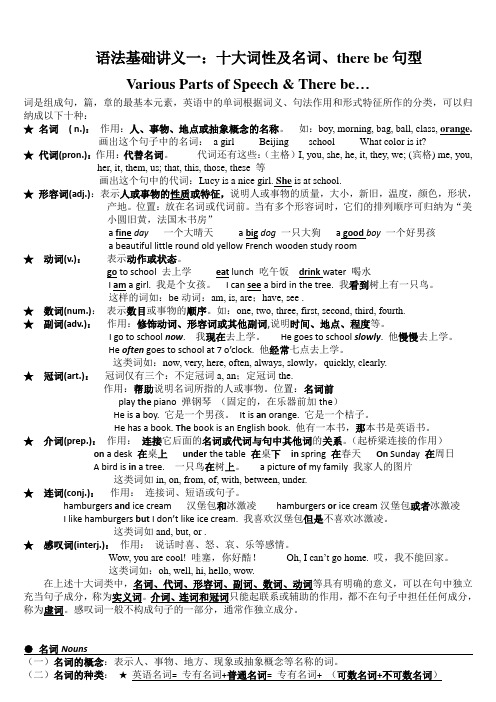
语法基础讲义一:十大词性及名词、there be句型Various Parts of Speech & There be…词是组成句,篇,章的最基本元素,英语中的单词根据词义、句法作用和形式特征所作的分类,可以归纳成以下十种:★名词( n.):作用:人、事物、地点或抽象概念的名称。
如:boy, morning, bag, ball, class, orange.画出这个句子中的名词: a girl Beijing school What color is it?★代词(pron.):作用:代替名词。
代词还有这些:(主格)I, you, she, he, it, they, we; (宾格) me, you, her, it, them, us; that, this, those, these 等画出这个句中的代词:Lucy is a nice girl. She is at school.★形容词(adj.):表示人或事物的性质或特征,说明人或事物的质量,大小,新旧,温度,颜色,形状,产地。
位置:放在名词或代词前。
当有多个形容词时,它们的排列顺序可归纳为“美小圆旧黄,法国木书房”a fine day一个大晴天 a big dog一只大狗a good boy一个好男孩a beautiful little round old yellow French wooden study room★动词(v.):表示动作或状态。
go to school 去上学eat lunch 吃午饭drink water 喝水I am a girl. 我是个女孩。
I can see a bird in the tree. 我看到树上有一只鸟。
这样的词如:be动词:am, is, are;have, see .★数词(num.):表示数目或事物的顺序。
如:one, two, three, first, second, third, fourth.★副词(adv.):作用:修饰动词、形容词或其他副词,说明时间、地点、程度等。
最新十大词性 句子成分及基本句型讲解及练习(附答案)
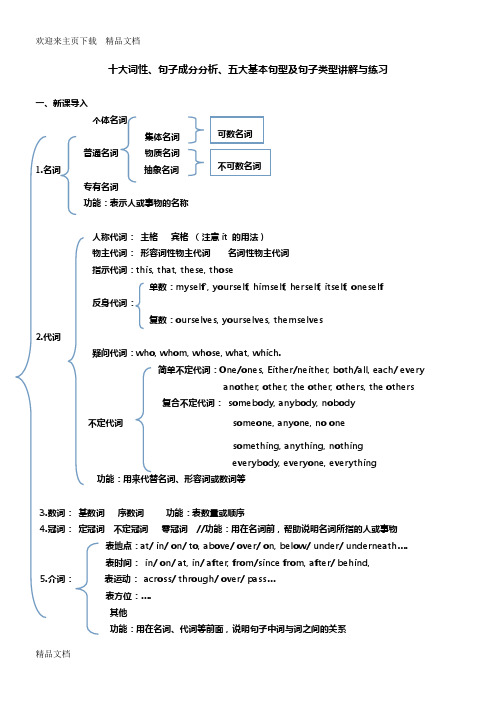
十大词性、句子成分分析、五大基本句型及句子类型讲解与练习一、新课导入个体名词集体名词普通名词 物质名词1.名词 抽象名词专有名词功能:表示人或事物的名称人称代词: 主格 宾格 (注意it 的用法)物主代词: 形容词性物主代词 名词性物主代词指示代词:this, that, these, those单数:myself`, yourself, himself, herself, itself, oneself反身代词:复数:ourselves, yourselves, themselves2.代词疑问代词:who, whom, whose, what, which.简单不定代词:One/ones, Either/neither, both/all, each/ everyanother, other, the other, others, the others复合不定代词: somebody, anybody, nobody不定代词 someone, anyone, no onesomething, anything, nothingeverybody, everyone, everything功能:用来代替名词、形容词或数词等3.数词: 基数词 序数词 功能:表数量或顺序4.冠词: 定冠词 不定冠词 零冠词 //功能:用在名词前,帮助说明名词所指的人或事物表地点:at/ in/ on/ to, above/ over/ on, below/ under/ underneath ….表时间: in/ on/ at, in/ after, from/since from, after/ behind,5.介词: 表运动: across/ through/ over/ pass …表方位:….其他功能:用在名词、代词等前面,说明句子中词与词之间的关系可数名词不可数名词6.形容词:平级、比较级、最高级功能:用来修饰名词,表示人或事物的特性、性质7. 副词:平级、比较级、最高级功能:用来修饰动词、形容词或其他副词,表示动作或形状的特性并列连词:and/ both/ or/ not only…but also, but/however/ yet/ still/ while…8. 连词:从属连词: if/ unless, because/as/ since, although/though…功能:用来连接词、短语或句子实义动词(vi./vt.)系动词助动词9. 动词:情态动词不定式(to do)非谓语动词分词: 现在分词(-ing)和过去分词(-ed)动名词(-ing)功能:表示人或事物的动作或状态10. 感叹词:oh ah well…功能:表示说话时的感情或口气课前小测:1.句子成分摸底测试:(1)指出下列句子划线部分是句子的什么成分?1)The students got on the school bus.2)He handed me the newspaper.3)I shall answer your questions after class.4)What a beautiful Chinese painting!5)They went hunting together early in the morning.(2)判断下列句子是简单句并列句还是复合句?1)We often study Chinese history on Friday afternoon.2)The boy who offered me his seat is called Tom.3)There is a chair in this room, isn’t there?4)My brother and I go to school at half past seven in the morning.5)He is in Class One and I am in Class Two.二:新课讲解:(一)句子成分七种句子成分:主语、谓语、宾语(直接宾语、间接宾语)、定语、状语、补语、表语等。
(word完整版)十大词性 句子成分及基本句型讲解及练习(附答案)

十大词性、句子成分分析、五大基本句型及句子类型讲解与练习一、新课导入个体名词 集体名词普通名词 物质名词 1.名词 抽象名词 专有名词功能:表示人或事物的名称人称代词: 主格 宾格 (注意it 的用法)物主代词: 形容词性物主代词 名词性物主代词指示代词:this, that, these, those单数:myself`, yourself , himself, herself , itself , oneself反身代词:复数:ourselves, yourselves, themselves2。
代词疑问代词:who, whom, whose , what, which 。
简单不定代词:One/ones, Either/neither , both/all, each/ everyanother, other , the other, others, the others复合不定代词: somebody , anybody, nobody不定代词 someone , anyone, no onesomething , anything , nothingeverybody, everyone, everything功能:用来代替名词、形容词或数词等3.数词: 基数词 序数词 功能:表数量或顺序4。
冠词: 定冠词 不定冠词 零冠词 //功能:用在名词前,帮助说明名词所指的人或事物表地点:at/ in/ on/ to, above/ over/ on , below/ under/ underneath …。
表时间: in/ on/ at , in/ after, from/since from, after/ behind,5.介词: 表运动: across/ through/ over/ pass …表方位:….其他功能:用在名词、代词等前面,说明句子中词与词之间的关系6. 形容词: 平级、比较级、最高级功能:用来修饰名词,表示人或事物的特性、性质7。
高中英语语法专题讲解:词性、成分与句子结构附练习题

高中英语语法专题讲解词性、成分与句子结构(一)词性一、四大词性与句子结构紧密相关1. 名词:主语、宾语、表语、同位语2. 动词:谓语3. 形容词:定语、表语、补语4. 副词:状语二、其他词性1. 代词:主宾表2. 疑问词who, whom, whose, what, which(主宾语,两个例外)when, where, why, how(状)(二)句子成分主、谓、宾、定、状、补、表、同位。
句子成分口诀:主谓宾,定状补,主干枝叶分清楚。
主干成分主谓宾,枝叶成分定状补。
定语必居主宾前,谓前为状谓后补。
状语有时位主前,逗号分开心有数。
基本成分主谓宾,连带成分定状补。
主语宾语adj.物主代词(定语)n.物主代词(主宾表)反身代词(宾表)我I me my mine myself我们we us our ours ourselves你you you your yours yourself你们you you your yours yourselves他he him his his himself她she her her hers herself它it it its its itself他们they them their theirs themselvesNo news is good news. 没消息就是好消息。
一、主语:句子开头的、动词/助动词或be 之前的那个成分。
充当主语的有:名词、代词、名词短语、动词不定式、动名词、从句。
I like dancing.The girl is very smart.Xiao Ming would go to the countryside to see his grandpa.二、谓语:主语后面的动词或动词词组。
She made a speech at the meeting.The old man took care of the kid many years ago.Flight 258 is taking off.三、宾语(由名词、代词、名词短语、动词不定式、动名词、从句充当):牢记两个词:动宾、介宾1. 动宾:及物动词之后的宾语。
(完整版)英语十大词性、句子成分及五种基本句型

模块一:句子结构【重点】一、词性的概念:英语中的单词根据词义、句法作用和形式特征所作的分类。
共有十类:名词、动词、形容词、代词、数词、冠词、副词、介词、连词、感叹词。
1、名词,"名"就是名称---人或事物的名称.具体的人或物体的名称:人名---Mike, LiMing; 地名—America, China 动物名---pig, dog; 植物名---tree, wheat。
抽象的事物的名称:idea(主意), victory(胜利), knowledge(知识).2、代词,何谓“代”?即是替代的意思,主要是来替代名词,所以说名词和代词关系是很近的,或者说代词的实质就是名词,正是这种血液关系,绝大多数时候代词跟名词在句中起的作用是一样的。
代词,从英语词汇的整体来看数量并不多。
3、动词,"动"就是动作--人的五官动作: walk, jump, swim;人的大脑动作(心理活动):think, imagine。
也有些动词是表示静止的,如:am,is,are。
4、形容词,我们在谈论人或物时,常说:“你描述一下是什么样子。
”你就要用上:tall(高的),short矮的),black(黑的),white(白的)这些词往往是修饰名词,它们就是形容词。
5、副词,说人行走得快慢,讲话清楚,在英语里就要用quickly(快地),slowly(慢地),clearly(清楚地)这些词往往来修饰动词。
它们就是副词。
副词很多是从形容词加ly构成的,所以看单词词尾是否有ly是判断是否是副词的一种方法,但是词尾是ly的也不一定都是副词,可能是形容词,不过只有少量的单词(常见的有likely,friendly lovely,lonely,weekly,monthly,yearly ), 这几个单词需要加强记忆,也不就是几个单词特殊嘛,不过考试往往就考特殊的,你要小心才是呀!6、介词,英语用词里介词也属于难缠的一个。
最新十大词性句子成分及基本句型讲解及练习(附答案)
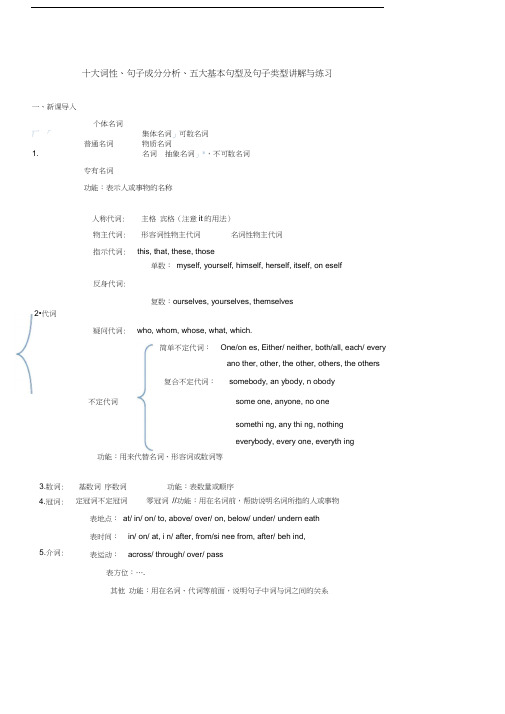
十大词性、句子成分分析、五大基本句型及句子类型讲解与练习一、新课导入个体名词厂 「集体名词」可数名词 普通名词物质名词1.名词 抽象名词」*,不可数名词专有名词功能:表示人或事物的名称单数: myself, yourself, himself, herself, itself, on eself反身代词:复数:ourselves, yourselves, themselves功能:用来代替名词、形容词或数词等定冠词不定冠词 零冠词 //功能:用在名词前,帮助说明名词所指的人或事物表地点: at/ in/ on/ to, above/ over/ on, below/ under/ undern eath 表时间: in/ on/ at, i n/ after, from/si nee from, after/ beh ind,表运动: across/ through/ over/ pass表方位:….其他 功能:用在名词、代词等前面,说明句子中词与词之间的关系人称代词: 主格 宾格(注意it 的用法) 物主代词:形容词性物主代词名词性物主代词指示代词: this, that, these, those2•代词疑问代词: who, whom, whose, what, which.简单不定代词: One/on es, Either/ neither, both/all, each/ everyano ther, other, the other, others, the others复合不定代词:somebody, an ybody, n obody some one, anyone, no one somethi ng, any thi ng, nothing everybody, every one, everyth ing3.数词:基数词 序数词 功能:表数量或顺序4.冠词:5.介词:不定代词8. 6.形容词:平级、比较级、最高级功能:用来修饰名词,表示人或事物的特性、性质7.副词:平级、比较级、最高级功能:用来修饰动词、形容词或其他副词,表示动作或形状的特性连词:9.动词:并歹U 连词: and/ both/ or/ not only …but also, but/however/ yet/ still/ while从属连词:if/ uni ess, because/as/ since, although/though 功能:用来连接词、短语或句子实义动词 (vi./vt.) 系动词 助动词情态动词不定式(to do )非谓语动词分词:现在分词(-ing )和 过去分词(-ed )I 动名词(-ing )功能:表示人或事物的动作或状态oh ah well …功能:表示说话时的感情或口气课前小测:1. 句子成分摸底测试:(1)指出下列句子划线部分是句子的什么成分?1) The stude nts got on the school bus.2) He han ded me the n ewspaper.3) I shall an swer your questi ons after class.4) What a beautiful Chin ese pain ti ng!5) They went hun ti ng together early in the morning.(2)判断下列句子是简单句并列句还是复合句?1) We ofte n study Chin ese history on Friday after noon.2) The boy who offered me his seat is called Tom.3) There is a chair in this room, isn ' t there?4) My brother and I go to school at half past seve n in the morning.5) He is in Class One and I am in Class Two.:新课讲解:(一)句子成分七种句子成分:主语、谓语、宾语(直接宾语、间接宾语)、定语、状语、补语、表语等。
(完整版)英语句子成分和结构讲解分析划分与练习及答案
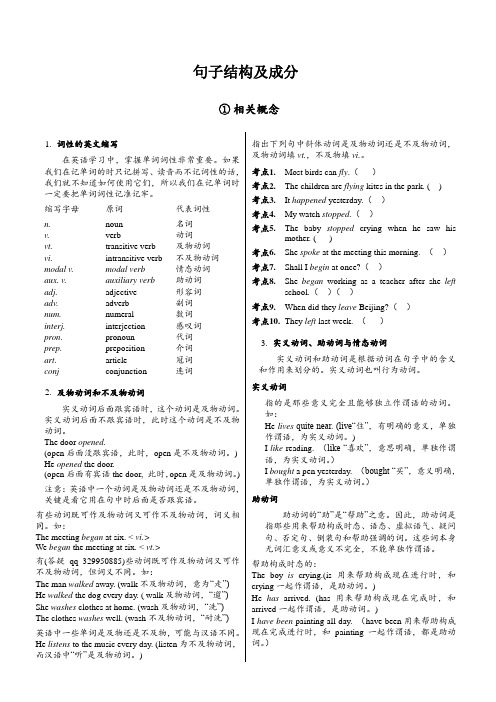
考点7.The girls are singing over there are my classmates.
在那边唱歌的那些女孩是我的同学。
考点8.My parents wanted him work hard.
我父母亲想让他努力学习。
考点9.I remember saw him that day.
先找出句中的谓语,然后改正句中的错误,并说明原因。
考点1.Get up early is good for our health.
早起有利于我们的身体健康。
考点2.I want go home now.我现在想回家。
考点3.My favorite sport is play football.
我最喜爱的运动是踢足球。
Hehas hadbreakfast. (has是助动词,帮助构成现在完成时,(答疑qq 329950885)had是实义动词,意为“吃”。has had一起构成了句子的谓语。)
指出下列斜体单词是实义动词还是助动词。
i.Does( ) helike( ) swimming?
ii.Hedoes( )like( ) swimming.
考点8.Shebeganworking as a teacher after sheleftschool.()()
考点9.When did theyleaveBeijing?()
考点10.Theyleftlast week.()
3.实义动词、助动词与情态动词
实义动词和助动词是根据动词在句子中的含义和作用来划分的。实义动词也叫行为动词。
conjconjunction连词
2.及物动词和不及物动词
实义动词后面跟宾语时,这个动词是及物动词。实义动词后面不跟宾语时,此时这个动词是不及物动词。
初中词性短语结构类型句子成分讲解及练习附答案
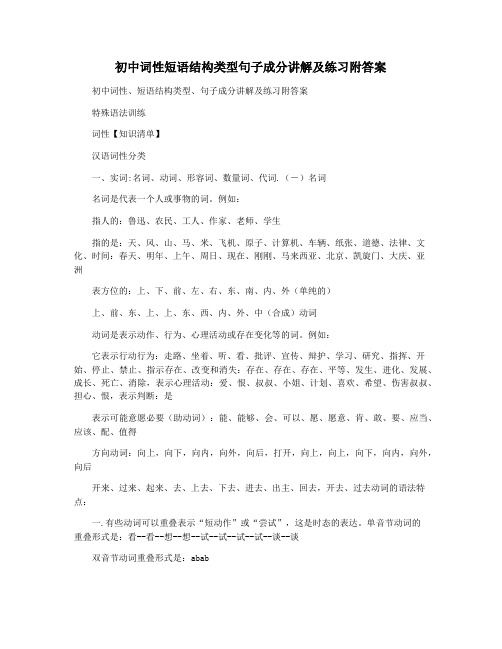
初中词性短语结构类型句子成分讲解及练习附答案初中词性、短语结构类型、句子成分讲解及练习附答案特殊语法训练词性【知识清单】汉语词性分类一、实词:名词、动词、形容词、数量词、代词.(-)名词名词是代表一个人或事物的词。
例如:指人的:鲁迅、农民、工人、作家、老师、学生指的是:天、风、山、马、米、飞机、原子、计算机、车辆、纸张、道德、法律、文化、时间:春天、明年、上午、周日、现在、刚刚、马来西亚、北京、凯旋门、大庆、亚洲表方位的:上、下、前、左、右、东、南、内、外(单纯的)上、前、东、上、上、东、西、内、外、中(合成)动词动词是表示动作、行为、心理活动或存在变化等的词。
例如:它表示行动行为:走路、坐着、听、看、批评、宣传、辩护、学习、研究、指挥、开始、停止、禁止、指示存在、改变和消失:存在、存在、存在、平等、发生、进化、发展、成长、死亡、消除,表示心理活动:爱、恨、叔叔、小姐、计划、喜欢、希望、伤害叔叔、担心、恨,表示判断:是表示可能意愿必要(助动词):能、能够、会、可以、愿、愿意、肯、敢、要、应当、应该、配、值得方向动词:向上,向下,向内,向外,向后,打开,向上,向上,向下,向内,向外,向后开来、过来、起来、去、上去、下去、进去、出主、回去,开去、过去动词的语法特点:一.有些动词可以重叠表示“短动作”或“尝试”,这是时态的表达。
单音节动词的重叠形式是:看--看--想--想--试--试--试--试--谈--谈双音节动词重叠形式是:abab学习--学习--批评--批评--讨论--讨论--休息--休息动词更复杂,有些需要解释。
1.动词“是”i.“是”用在名词前边是动词,这种“是”常常表示主语“等于什么”或“属于什么”。
例如“鲁迅就是周树人”、“牛是反刍动物”、“他是个开车的”、“是他救了我”;此外,“这一年,人家都是丰年,我是歉年,收完秋就没吃的了”等里面的“是”仍是动词,作谓语。
二、“是”用在动词和形容词前面,表示肯定,包含“确实”和“现实”的含义。
英语句子成分分析_十大词类及练习
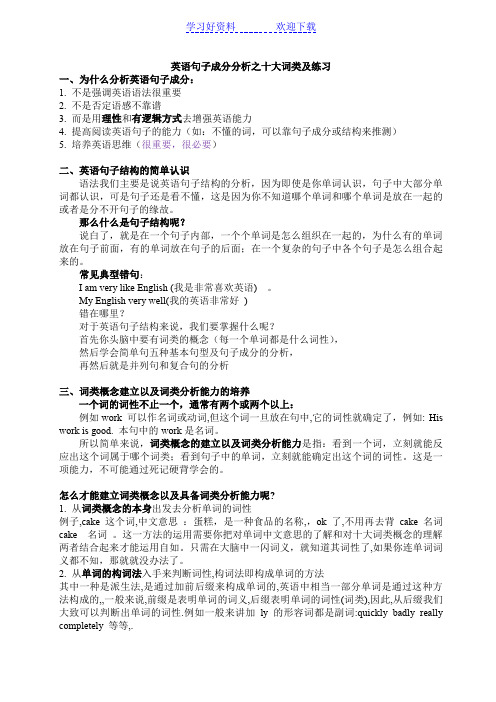
英语句子成分分析之十大词类及练习一、为什么分析英语句子成分:1. 不是强调英语语法很重要2. 不是否定语感不靠谱3. 而是用理性和有逻辑方式去增强英语能力4. 提高阅读英语句子的能力(如:不懂的词,可以靠句子成分或结构来推测)5. 培养英语思维(很重要,很必要)二、英语句子结构的简单认识语法我们主要是说英语句子结构的分析,因为即使是你单词认识,句子中大部分单词都认识,可是句子还是看不懂,这是因为你不知道哪个单词和哪个单词是放在一起的或者是分不开句子的缘故。
那么什么是句子结构呢?说白了,就是在一个句子内部,一个个单词是怎么组织在一起的,为什么有的单词放在句子前面,有的单词放在句子的后面;在一个复杂的句子中各个句子是怎么组合起来的。
常见典型错句:I am very like English (我是非常喜欢英语) 。
My English very well(我的英语非常好)错在哪里?对于英语句子结构来说,我们要掌握什么呢?首先你头脑中要有词类的概念(每一个单词都是什么词性),然后学会简单句五种基本句型及句子成分的分析,再然后就是并列句和复合句的分析三、词类概念建立以及词类分析能力的培养一个词的词性不止一个,通常有两个或两个以上:例如work 可以作名词或动词,但这个词一旦放在句中,它的词性就确定了,例如: His work is good. 本句中的work是名词。
所以简单来说,词类概念的建立以及词类分析能力是指:看到一个词,立刻就能反应出这个词属于哪个词类;看到句子中的单词,立刻就能确定出这个词的词性。
这是一项能力,不可能通过死记硬背学会的。
怎么才能建立词类概念以及具备词类分析能力呢?1. 从词类概念的本身出发去分析单词的词性例子,cake 这个词,中文意思:蛋糕,是一种食品的名称,,ok 了,不用再去背cake 名词cake 名词。
这一方法的运用需要你把对单词中文意思的了解和对十大词类概念的理解两者结合起来才能运用自如。
十大词性-句子成分及基本句型讲解及练习(附答案)(汇编)
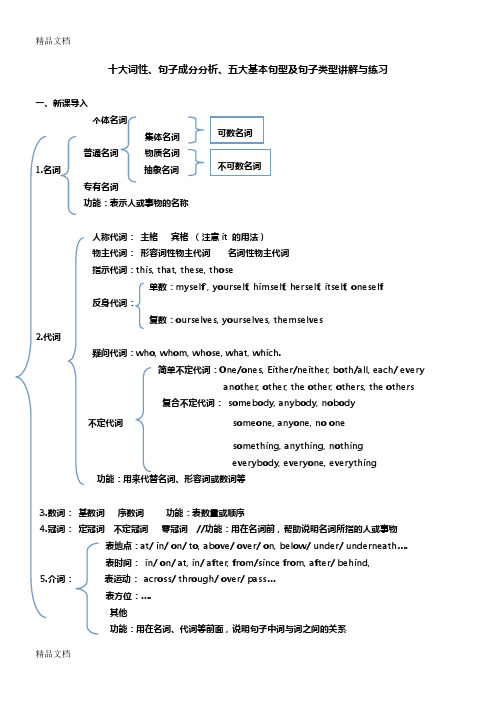
十大词性、句子成分分析、五大基本句型及句子类型讲解与练习一、新课导入个体名词集体名词普通名词 物质名词1.名词 抽象名词专有名词功能:表示人或事物的名称人称代词: 主格 宾格 (注意it 的用法)物主代词: 形容词性物主代词 名词性物主代词指示代词:this, that, these, those单数:myself`, yourself, himself, herself, itself, oneself反身代词:复数:ourselves, yourselves, themselves2.代词疑问代词:who, whom, whose, what, which.简单不定代词:One/ones, Either/neither, both/all, each/ everyanother, other, the other, others, the others复合不定代词: somebody, anybody, nobody不定代词 someone, anyone, no onesomething, anything, nothingeverybody, everyone, everything功能:用来代替名词、形容词或数词等3.数词: 基数词 序数词 功能:表数量或顺序4.冠词: 定冠词 不定冠词 零冠词 //功能:用在名词前,帮助说明名词所指的人或事物表地点:at/ in/ on/ to, above/ over/ on, below/ under/ underneath ….表时间: in/ on/ at, in/ after, from/since from, after/ behind,5.介词: 表运动: across/ through/ over/ pass …表方位:….其他功能:用在名词、代词等前面,说明句子中词与词之间的关系可数名词不可数名词6.形容词:平级、比较级、最高级功能:用来修饰名词,表示人或事物的特性、性质7. 副词:平级、比较级、最高级功能:用来修饰动词、形容词或其他副词,表示动作或形状的特性并列连词:and/ both/ or/ not only…but also, but/however/ yet/ still/ while…8. 连词:从属连词: if/ unless, because/as/ since, although/though…功能:用来连接词、短语或句子实义动词(vi./vt.)系动词助动词9. 动词:情态动词不定式(to do)非谓语动词分词: 现在分词(-ing)和过去分词(-ed)动名词(-ing)功能:表示人或事物的动作或状态10. 感叹词:oh ah well…功能:表示说话时的感情或口气课前小测:1.句子成分摸底测试:(1)指出下列句子划线部分是句子的什么成分?1)The students got on the school bus.2)He handed me the newspaper.3)I shall answer your questions after class.4)What a beautiful Chinese painting!5)They went hunting together early in the morning.(2)判断下列句子是简单句并列句还是复合句?1)We often study Chinese history on Friday afternoon.2)The boy who offered me his seat is called Tom.3)There is a chair in this room, isn’t there?4)My brother and I go to school at half past seven in the morning.5)He is in Class One and I am in Class Two.二:新课讲解:(一)句子成分七种句子成分:主语、谓语、宾语(直接宾语、间接宾语)、定语、状语、补语、表语等。
(2021年整理)初中英语十大词性详解和练习

初中英语十大词性详解和练习(推荐完整)编辑整理:尊敬的读者朋友们:这里是精品文档编辑中心,本文档内容是由我和我的同事精心编辑整理后发布的,发布之前我们对文中内容进行仔细校对,但是难免会有疏漏的地方,但是任然希望(初中英语十大词性详解和练习(推荐完整))的内容能够给您的工作和学习带来便利。
同时也真诚的希望收到您的建议和反馈,这将是我们进步的源泉,前进的动力。
本文可编辑可修改,如果觉得对您有帮助请收藏以便随时查阅,最后祝您生活愉快业绩进步,以下为初中英语十大词性详解和练习(推荐完整)的全部内容。
初中英语十大词性详解和练习(推荐完整)编辑整理:张嬗雒老师尊敬的读者朋友们:这里是精品文档编辑中心,本文档内容是由我和我的同事精心编辑整理后发布到文库,发布之前我们对文中内容进行仔细校对,但是难免会有疏漏的地方,但是我们任然希望初中英语十大词性详解和练习(推荐完整)这篇文档能够给您的工作和学习带来便利。
同时我们也真诚的希望收到您的建议和反馈到下面的留言区,这将是我们进步的源泉,前进的动力。
本文可编辑可修改,如果觉得对您有帮助请下载收藏以便随时查阅,最后祝您生活愉快业绩进步,以下为 <初中英语十大词性详解和练习(推荐完整)> 这篇文档的全部内容。
在英语中,共有10大词类,它们是:名词、动词、形容词、副词、数词、代词、冠词、介词、连词、感叹词。
一、名词1、什么叫名词?名词是表示人、事物、地点或抽象概念的名称。
如:mother妈妈 panda熊猫 library 图书馆 pencil 铅笔 wish愿望2、名词分类(1)专有名词表示特定的人或事物的名称.如:Mr. Green格林先生 the Spring Festival春节 the Great Wall长城 Britain英国提示:关于单词首字母大写1、句首的第一个单词的首字母要大写,Today is Thursday.2、人名:姓和名两个单词第一个字母都大写,Mr. Ye, Mrs. Zhang3、称呼、头衔的第一个字母要大写,Doctor Wang, Chairman Mao4、国家、地名等专有名词第一个字母要大写,Australia, Wuhan, Zhejiang, Wenzhou5、月份、星期几、节假日每个单词的第一个字母都要大写. March, Tuesday,National Day, Labour Day6、语言名称要大写。
英语句子成分和结构讲解分析划分与练习及答案

英语句子成分和结构讲解分析划分与练习及答案句子结构及成分①相关概念1.词性的英文缩写在英语学习中,掌握单词词性非常重要。
如果我们在记单词的时只记拼写、读音而不记词性的话,我们就不知道如何使用它们,所以我们在记单词时一定要把单词词性记准记牢。
缩写字母原词代表词性n. noun 名词v. verb 动词vt.transitive verb 及物动词vi.intransitive verb 不及物动词modal v. modal verb 情态动词aux. v. auxiliary verb 助动词adj.adjective 形容词adv.adverb 副词num. numeral 数词interj. interjection 感叹词pron. pronoun 代词prep.preposition 介词art. article 冠词conj conjunction 连词2.及物动词和不及物动词实义动词后面跟宾语时,这个动词是及物动词。
实义动词后面不跟宾语时,此时这个动词是不及物动词。
The door opened.(open后面没跟宾语,此时,open是不及物动词。
)He opened the door.(open后面有宾语the door, 此时,open是及物动词。
)注意:英语中一个动词是及物动词还是不及物动词,关键是看它用在句中时后面是否跟宾语。
有些动词既可作及物动词又可作不及物动词,词义相同。
如:The meeting began at six. < vi.>We began the meeting at six. < vt.>有些动词既可作及物动词又可作不及物动词,但词义不同。
如:The man walked away. (walk不及物动词,意为“走”)He walked the dog every day. ( walk及物动词,“遛”)She washes clothes at home. (wash及物动词,“洗”)The clothes washes well. (wash不及物动词,“耐洗”)英语中一些单词是及物还是不及物,可能与汉语不同。
英语句子成分和结构讲解分析划分与练习及答案

句子结构及成分①相关概念1.词性的英文缩写在英语学习中,掌握单词词性非常重要。
如果我们在记单词的时只记拼写、读音而不记词性的话,我们就不知道如何使用它们,所以我们在记单词时一定要把单词词性记准记牢。
缩写字母原词代表词性n. noun 名词v. verb 动词vt.transitive verb 及物动词vi.intransitive verb 不及物动词modal v. modal verb 情态动词aux. v. auxiliary verb 助动词adj.adjective 形容词adv.adverb 副词num. numeral 数词interj. interjection 感叹词pron. pronoun 代词prep.preposition 介词art. article 冠词conj conjunction 连词2.及物动词和不及物动词实义动词后面跟宾语时,这个动词是及物动词。
实义动词后面不跟宾语时,此时这个动词是不及物动词。
The door opened.(open后面没跟宾语,此时,open是不及物动词。
)He opened the door.(open后面有宾语the door, 此时,open是及物动词。
)注意:英语中一个动词是及物动词还是不及物动词,关键是看它用在句中时后面是否跟宾语。
有些动词既可作及物动词又可作不及物动词,词义相同。
如:The meeting began at six. < vi.>We began the meeting at six. < vt.>有些动词既可作及物动词又可作不及物动词,但词义不同。
如:The man walked away. (walk不及物动词,意为“走”)He walked the dog every day. ( walk及物动词,“遛”)She washes clothes at home. (wash及物动词,“洗”)The clothes washes well. (wash不及物动词,“耐洗”)英语中一些单词是及物还是不及物,可能与汉语不同。
英语句子成分和构架讲解分析划分与练习及答案

指出下列斜体单词是实义动词还是助动词。
i.Does()helike()swimming?
ii.Hedoes()like()swimming.
iii.Wheredoes()helive()?
句子结构及成分
1相关概念
1.词性的英文缩写
在英语学习中,掌握单词词性非常重要。如果我们在记单词的时只记拼写、读音而不记词性的话,我们就不知道如何使用它们,所以我们在记单词时一定要把单词词性记准记牢。
缩写字母原词代表词性
n.noun名词
v.verb动词
vt.transitiveverb及物动词
vi.intransitiveverb不及物动词
10.Isawhimwalkedintothebuilding.
我看到他跑进那座建筑物。
5.主动关系和被动关系
先看下面两个题:
1.______wonderful,thiskindoffoodenjoyedagoodsale.
2.A.TastedB.Beingtasted
3.C.TastingD.Havingtasted
Heaskedmetolendhimsomemoney.他让我借给他一些钱。
“me”是宾语,“metolendhimsomemoney”意为“我借给他一些钱”。从意思上看,这像一句话,“我”是主语,“借给他一些钱”是谓语部分,但在英语原句中,它们却不是真正的主谓关系。因此可以说“逻辑上的主谓关系”,是指,从意思上看像主谓关系,而实际上不是。“tolendhimsomemoney”是宾语补足语。
初中词性、短语结构类型、句子成分讲解及练习附答案

语法专项训练词性【知识清单】汉语词性分类一、实词:名词、动词、形容词、数量词、代词.(-)名词名词是表示人或事物的词。
例如:指人的:鲁迅、农民、工人、作家、老师、学生指物的:日、风、山、马、稻子、飞机、原子、计算机、车辆、纸张、道德、法律、文化表时间的:春天、明年、早晨、星期天、现在、刚才表处所的:马来西亚、北京、凯旋门、大庆、亚洲表方位的:上、下、前、左、右、东、南、内、外(单纯的)以上、以前、以东、上边、上面、东边、西边、里头、外头、中间(合成的)(二)动词动词是表示动作、行为、心理活动或存在变化等的词。
例如:表示动作行为:走、坐、听、看、批评、宣传、保卫、学习、研究、进行、开始、停止、禁止表示存在变化消失:存在、在、有、等于、发生、演变、发展、生长、死亡、消灭表示心理活动:爱、恨、伯、想念、打算、喜欢、希望、害伯、担心、讨厌表示判断:是表示可能意愿必要(助动词):能、能够、会、可以、愿、愿意、肯、敢、要、应当、应该、配、值得表示趋向(趋向动词):上、下、进、出、回、开、过、起、来、上来、下来、进来、出来、回来、开来、过来、起来、去、上去、下去、进去、出主、回去,开去、过去动词的语法特点:1.一部分动词可以重叠,表示“动作短暂”或“尝试”的意思,是时态的表示法。
单音节动词重叠形式是:AA看——看看想——想想试——试试讲——讲讲双音节动词重叠形式是:ABAB学习——学习学习批评——批评批评讨论——讨论讨论休息——休息休息动词比较复杂,有的需要加以说明。
1.动词“是”I. “是”用在名词前边是动词,这种“是”常常表示主语“等于什么”或“属于什么”。
例如“鲁迅就是周树人”、“牛是反刍动物”、“他是个开车的”、“是他救了我”;此外,“这一年,人家都是丰年,我是歉年,收完秋就没吃的了”等里面的“是”仍是动词,作谓语。
II. “是”用在动词、形容词前边,表示肯定,含有“的确”、“实在”的意思,可以看作语气副词,作状语,例如“我〔是〕懂了”、“他〔是〕勇敢”、“这样做〔是〕好”。
(完整版)英语十大词性、句子成分及五种基本句型.docx
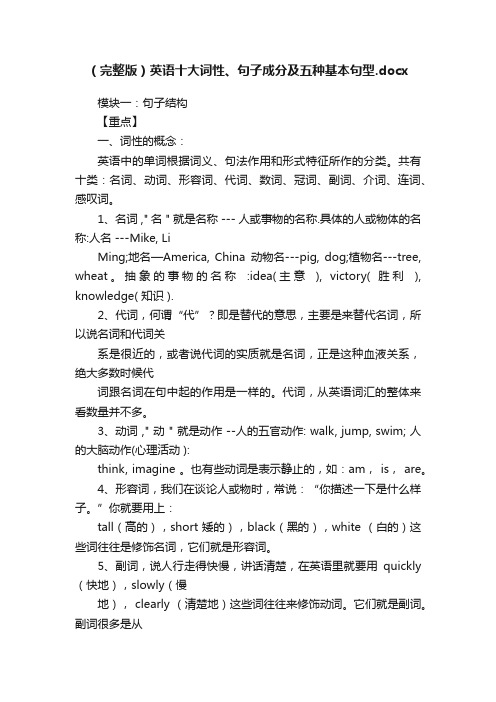
(完整版)英语十大词性、句子成分及五种基本句型.docx模块一:句子结构【重点】一、词性的概念:英语中的单词根据词义、句法作用和形式特征所作的分类。
共有十类:名词、动词、形容词、代词、数词、冠词、副词、介词、连词、感叹词。
1、名词 ," 名 " 就是名称 --- 人或事物的名称.具体的人或物体的名称:人名 ---Mike, LiMing;地名—America, China动物名---pig, dog;植物名---tree, wheat。
抽象的事物的名称:idea(主意), victory( 胜利), knowledge( 知识 ).2、代词,何谓“代”?即是替代的意思,主要是来替代名词,所以说名词和代词关系是很近的,或者说代词的实质就是名词,正是这种血液关系,绝大多数时候代词跟名词在句中起的作用是一样的。
代词,从英语词汇的整体来看数量并不多。
3、动词 ," 动 " 就是动作 --人的五官动作: walk, jump, swim; 人的大脑动作(心理活动 ):think, imagine 。
也有些动词是表示静止的,如:am, is, are。
4、形容词,我们在谈论人或物时,常说:“你描述一下是什么样子。
”你就要用上:tall(高的),short 矮的),black(黑的),white (白的)这些词往往是修饰名词,它们就是形容词。
5、副词,说人行走得快慢,讲话清楚,在英语里就要用quickly (快地),slowly(慢地), clearly (清楚地)这些词往往来修饰动词。
它们就是副词。
副词很多是从形容词加ly 构成的,所以看单词词尾是否有ly 是判断是否是副词的一种方法,但是词尾是ly 的也不一定都是副词,可能是形容词,不过只有少量的单词(常见的有likely , friendly lovely , lonely , weekly , monthly ,yearly ) , 这几个单词需要加强记忆,也不就是几个单词特殊嘛,不过考试往往就考特殊的,你要小心才是呀!6、介词,英语用词里介词也属于难缠的一个。
高中英语中的词性和成分语法详解,习题练习附答案

句子成分和句子类型一、知识框架二、知识梳理(一)句子成分句子成分的定义:构成句子的各个部分叫做句子成分。
句子成分有主要成分和次要成分;主要成分有主语和谓语;次要成分有表语、宾语、定语、状语、补足语和同位语。
1.主语:主语是一个句子所叙述的主体,一般位于句首。
但在there be结构、疑问句(当主语不疑问词时)和倒装句中,主语位于谓语、助动词或情态动词后面。
主语可由名词、代词、数词、不定式、动名词、名词化的形容词和主语从句等表示。
例如:During the 1990s, American country music has become more and more popular.(名词)We often speak English in class.(代词)One-third of the students in this class are girls.(数词)To swim in the river is a great pleasure.(不定式)Smoking does harm to the health.(动名词)The rich should help the poor.(名词化的形容词)When we are going to have an English test has not been decided.(主语从句)It is necessary to master a foreign language.(it作形式主语,真正的主语为后面的不定式)2.谓语:谓语说明主语所做的动作或具有的特征和状态。
动词在句中作谓语,一般放在主语之后。
谓语的构成如下:1、简单谓语:由一个动词或动词短语构成。
如:He practices running every morning.2、复合谓语:(1)由情态动词或其他助动词加动词原形构成。
如:You may keep the book for two weeks. He has caught a bad cold. (2)由系动词加表语构成。
- 1、下载文档前请自行甄别文档内容的完整性,平台不提供额外的编辑、内容补充、找答案等附加服务。
- 2、"仅部分预览"的文档,不可在线预览部分如存在完整性等问题,可反馈申请退款(可完整预览的文档不适用该条件!)。
- 3、如文档侵犯您的权益,请联系客服反馈,我们会尽快为您处理(人工客服工作时间:9:00-18:30)。
十大词性、句子成分分析、五大基本句型及句子类型讲解与练习一、新课导入个体名词集体名词 普通名词 物质名词 1.名词 抽象名词 专有名词功能:表示人或事物的名称人称代词: 主格 宾格 (注意it 的用法) 物主代词: 形容词性物主代词 名词性物主代词 指示代词:this, that, these, those单数:myself`, yourself, himself, herself, itself, oneself反身代词:复数:ourselves, yourselves, themselves 2.代词疑问代词:who, whom, whose, what, which.简单不定代词:One/ones, Either/neither, both/all, each/ everyanother, other, the other, others, the others复合不定代词: somebody, anybody, nobody 不定代词 someone, anyone, no one something, anything, nothing everybody, everyone, everything 功能:用来代替名词、形容词或数词等3.数词: 基数词 序数词 功能:表数量或顺序4.冠词: 定冠词 不定冠词 零冠词 //功能:用在名词前,帮助说明名词所指的人或事物 表地点:at/ in/ on/ to, above/ over/ on, below/ under/ underneath …. 表时间: in/ on/ at, in/ after, from/since from, after/ behind,5.介词: 表运动: across/ through/ over/ pass …表方位:….其他功能:用在名词、代词等前面,说明句子中词与词之间的关系6.形容词:平级、比较级、最高级功能:用来修饰名词,表示人或事物的特性、性质7. 副词:平级、比较级、最高级功能:用来修饰动词、形容词或其他副词,表示动作或形状的特性并列连词:and/ both/ or/ not only…but also, but/however/ yet/ still/ while…8. 连词:从属连词: if/ unless, because/as/ since, although/though…功能:用来连接词、短语或句子实义动词(vi./vt.)系动词助动词9. 动词:情态动词不定式(to do)非谓语动词分词: 现在分词(-ing)和过去分词(-ed)动名词(-ing)功能:表示人或事物的动作或状态10. 感叹词:oh ah well…功能:表示说话时的感情或口气课前小测:1.句子成分摸底测试:(1)指出下列句子划线部分是句子的什么成分?1)The students got on the school bus.2)He handed me the newspaper.3)I shall answer your questions after class.4)What a beautiful Chinese painting!5)They went hunting together early in the morning.(2)判断下列句子是简单句并列句还是复合句?1)We often study Chinese history on Friday afternoon.2)The boy who offered me his seat is called Tom.3)There is a chair in this room, isn’t there?4)My brother and I go to school at half past seven in the morning.5)He is in Class One and I am in Class Two.二:新课讲解:(一)句子成分七种句子成分:主语、谓语、宾语(直接宾语、间接宾语)、定语、状语、补语、表语等。
句子的主要部分是主语和谓语。
表语、宾语和补足语是谓语的组成部分。
其他成分如定语、状语、同位语是句子的次要成分。
1.主语(话题/主心骨)一句话的主体。
英语句子不可或缺的成分,是全句述说的主题。
常用的作主语的词类有:名词(短语)、代词、数词、名词化的形容词,不定式(短语)、动名词(短语)和从句。
George is a born leader. (名词)Nobody knew what had happened. (代词)Two of us will attend the conference tomorrow. (数词)The young are always willing to accept new things. (名词化的形容词)To go the bed early and to get up early is a good habit. (不定式短语)Losing his new MP4 made Tom very sad. (动名词短语)What we can’t get seems better than what we have. (名词性从句)It is necessary to master a foreign language. (不定式做主语)总结:正常语序情况下,主语在谓语动词之前。
2.谓语(动作/状态):说明主语做了什么动作,干了啥事。
位于主语之后。
谓语动词有人称、数、时态和语态等的变化。
简单谓语:由一个动词或动词短语构成。
Father cooks very well.He practices running every morning.复合谓语:由情态动词或其他助动词加动词原形构成。
My sister has worked in the company for five years.You may keep the book for two weeks.总结:谓语部分由动词,动词短语或系表结构构成。
3.宾语(被K 的对象——主语发出的各种动作都落在宾语身上)及物动词动作的对象和介词所联系的对象。
英语有单宾语、双宾语、复合宾语、同源宾语等。
双宾语又分为直接宾语和间接宾语。
凡能做主语的词、短语或从句都可以作宾语。
(1)单宾语(宾语)可以作宾语的成分主要有名词(短语)、代词、数词、名词化的形容词、名词化的分词、不定式(短语)、动名词(短语)、从句等。
I can hardly hear the radio. Would you please turn it up? (名词、代词)If you put 5 and 7 together, you’ll get 12, little Tom. (代词)We should help the poor. (名词化的形容词)Remember to tell him to come. (不定式)Please stop making noise. (动名词)Do you understand what I mean? (名词性从句)(2)双宾语(直接宾语&间接宾语)双宾语指动词后面接指人和物的两个宾语。
指人的宾语叫间接宾语,指物的宾语叫直接宾语。
其结构为:主语+ 及物动词(短语)+ sb. + sth.Please tell me how the accident came about.The teacher asked me a question too difficult to answer.(3)同源宾语少数不及物动词后面能跟一个特定的名词作宾语,这个名词和前面的动词在词根上相同的或者在意义上是相近的,这样的宾语就叫做同源宾语。
同源宾语前面常有修饰语。
laugh a good laugh 大笑blow a heavy blow 沉重的一击smile a sweet smile 甜甜的微笑dream a terrible dream 做了一个恶梦die a brave death 死得英勇live a happy life 过着幸福的生活4.表语(在系动词之后)说明主语是什么样的。
(身份状态特征类属性质等)表语与前面的系动词一起构成谓语。
His father is an experienced teacher. (名词)She is over fifty, but she doesn’t look it. (名词、代词)These students are careful while others are careless. (形容词)The class meeting was over at last. (副词)Be quiet; they are at work now. (介词短语)His hobby is collecting foreign stamps. (动名词短语)My wish is to become a doctor in the future. (不定式短语)The news of her success is really exciting. (现在分词)(已形容词化)That is where your mistakes are. (名词性从句)总结: 与系动词一起构成谓语。
5.定语(商品外包装——起修饰作用)定语是用来描述名词或代词的修饰语,它常和名词构成名词短语。
定语可分为前置定语和后置定语两种。
(1)前置定语可以充当前置定语的有形容词、代词、数词、名词和名词所有格、动词的-ing形式、动词的-ed形式等。
Many people have helped with (canned) food. (过去分词)Open (your) mouth and put out (your) tongue. (代词的所有格)She cut the cake into (two) pieces. (数词)I want to buy some (coffee) cups. (名词)Put the child in the (sleeping) bag. (动名词)You should adapt to the (changing) situation. (现在分词)(2)后置定语可以充当后置定语的有形容词,副词,介词短语,不定式(短语),动词的-ing短语,动词的-ed短语,从句等。
All people (present at the party) were his supporters. (形容词短语)I have got something (interesting) to tell every one of you. (形容词)The buildings (around) were badly damaged. (副词)The books (on the top shelf) were just bought. (介词短语)Let’s try another way (to do this). (不定式)There is a gentleman (asking to see you). (现在分词短语)Most of the people (invited to the party) were famous scientists. (过去分词)He lost his new pen (that was bought last week). (定语从句)6. 状语(商品标签)状语是用来修饰动词,形容词,副词或句子的一种句子成分。
